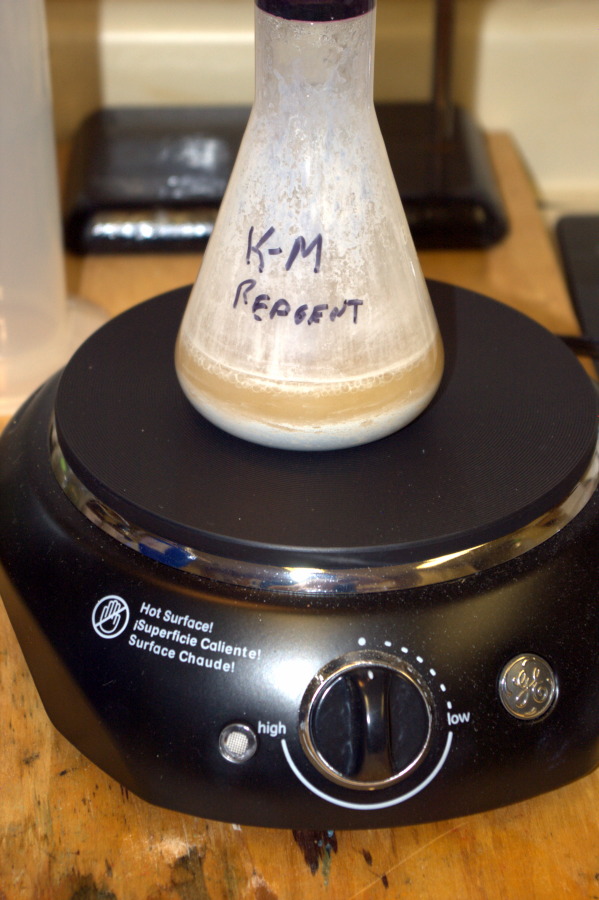07:41 – You’ve probably seen phenolphthalein used as an acid-base indicator. In solutions ranging from acidic to moderately basic, phenolphthalein is colorless; at pH 10 and higher, phenolphthalein is fuchsia. (Okay, “fuchsia” is a girl-color, and I annoy Barbara by pronouncing it as German. Guys would call the color “pink”, or, if they’re into photography and imaging, perhaps “magenta”.)
At any rate, the forensics kit includes a 30 mL bottle of Kastle-Meyer reagent, a presumptive color test for blood. I had planned to buy the stuff premade, figuring it might cost me $30/liter or thereabouts. Instead, I found several suppliers, the least expensive of which was charging $230/liter. Geez. Obviously, taxpayer-funded law enforcement agencies aren’t too concerned about price.
It’s easy enough to make the stuff up, so that’s what I’ll do. All it requires per liter is 20 g of phenolphthalein, 200 g of sodium or potassium hydroxide, and about the same amount of zinc. You start by dissolving the hydroxide in about 900 mL of distilled or deionized water. Phenolphthalein powder is extraordinary insoluble in water, but freely soluble in a strong aqueous base solution. (And a 20% w/v solution of sodium or potassium hydroxide counts as a “strong aqueous base solution” in spades…)
Of course, as the phenolphthalein powder dissolves, the solution turns an incredibly intense fuchsia color. That’s where the zinc comes in. It reduces the phenolphthalein to pale yellow phenolphthalin. The instructions for making up KM reagent always talk about refluxing the solution until the pink color changes to pale yellow. I was hoping to avoid refluxing large volumes of a 20% hydroxide solution–the stuff is fearsome enough at room temperature, let alone boiling–so I decided to make up a small sample batch at room temperature. I made up 100 mL and let the stuff sit at room temperature for two or three weeks, with occasional swirling. Over that time, it turned from pure pink to an orangish pink.
So yesterday, I decided to speed things up a bit by refluxing the solution. The problem with that is that strong hydroxide solutions literally dissolve glass, even at room temperature. At boiling, they simply eat glass. After two or three weeks of contact, the 250 mL Erlenmeyer flask that I’d made up the solution in originally was already etched, so I decided to see what would happen at boiling. The image below shows the grisly details. What look like white chemical deposits on the sides of the flask is actual where the glass has been etched. But the good news is that after only 30 minutes or so of refluxing the solution has assumed its final light yellow color.
This little experiment did lead to a change in plans, however. I was expecting to have to reflux the solution for at least two or three hours. To do that refluxing in volume, I planned to buy a large round-bottom flask (or several) and a Graham condenser with ground-glass joints, and dedicate them to making up KM reagent. If you’ve ever priced glassware with ground-glass joints, you know how costly it is. Even the Chinese stuff ain’t cheap, and I’m not at all sure how many iterations the flask and condenser would survive. So I decided instead to order some large (2 L to 5 L) Erlenmeyer flasks, which aren’t cheap, but they’re a lot cheaper than ground-glass glassware. And I won’t need a reflux condenser at all. For the sample batch, I simply placed a one-hole stopper loosely in the neck of the 250 mL Erlenmeyer, brought the solution to a boil and then turned it down to simmer. There was a small amount of steam exiting the hole in the stopper, but not enough to noticeably reduce the volume of the solution over the whole reflux period.

